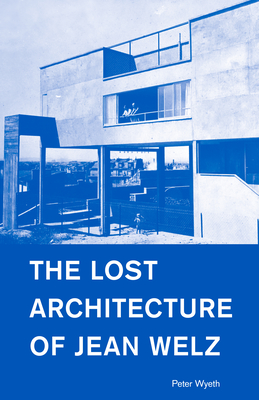The Lost Architecture of Jean Welz

The Lost Architecture of Jean Welz
Endorsements by lead architectural scholars from universities in the UK, US and Europe, including Tim Benton, a Le Corbusier expert and Christopher Long, who has published at least a dozen books on Viennese modern architecture and Adolf Loos. A must acquisition for libraries and of interest to students.
Tale of discovery, intriguing for the everyday reader: A treasure hunt in the rich and radical artistic interwar period of the 1920s and 1930s in Paris that then travels across three countries and two continents over a decade of research. The book feels like a race against crumbling history told by a filmmaker in vivid detail as he uncovers Welz's past, his musical and artistic abilities, and his greatest designs.
First use of exterior béton brut identified: Welz's Maison Zilveli (Paris 1933) with its airborne main floor, views of Sacre Coeur and the Eiffel Tower, and the lost, perilous balcony, are bold ideas that will light up readers' imaginations in this race against crumbling history. The concrete balcony balanced on a thin blade only 6 cm thick, is the first use of exterior béton brut identified.
Illustrations and book design: spot color washes, tints, and highlighted text using period fonts, color plates. 3-D renderings and axonometric schemes visually bring the architecture to life. Plans and sketches of unbuilt projects, treatises on art published in South Africa, and period magazine articles provide important context. Fine examples of Welz's paintings included, linking his abstract works to his philosophy of architecture.
Controversies provide press hooks: South Africa's leading modern architect Rex Martiennsen took unacknowledged cues from a Welz Paris house to create his best-known design, though at least one of Martiennsen's colleagues publicly questioned his influences. Jean Welz's estranged brother Friedrich Welz was an infamously unscrupulous art dealer in Vienna and an SS officer, made famous in the 1997 Holocau
PRP: 226.12 Lei
Acesta este Prețul Recomandat de Producător. Prețul de vânzare al produsului este afișat mai jos.
203.51Lei
203.51Lei
226.12 LeiLivrare in 2-4 saptamani
Descrierea produsului
Endorsements by lead architectural scholars from universities in the UK, US and Europe, including Tim Benton, a Le Corbusier expert and Christopher Long, who has published at least a dozen books on Viennese modern architecture and Adolf Loos. A must acquisition for libraries and of interest to students.
Tale of discovery, intriguing for the everyday reader: A treasure hunt in the rich and radical artistic interwar period of the 1920s and 1930s in Paris that then travels across three countries and two continents over a decade of research. The book feels like a race against crumbling history told by a filmmaker in vivid detail as he uncovers Welz's past, his musical and artistic abilities, and his greatest designs.
First use of exterior béton brut identified: Welz's Maison Zilveli (Paris 1933) with its airborne main floor, views of Sacre Coeur and the Eiffel Tower, and the lost, perilous balcony, are bold ideas that will light up readers' imaginations in this race against crumbling history. The concrete balcony balanced on a thin blade only 6 cm thick, is the first use of exterior béton brut identified.
Illustrations and book design: spot color washes, tints, and highlighted text using period fonts, color plates. 3-D renderings and axonometric schemes visually bring the architecture to life. Plans and sketches of unbuilt projects, treatises on art published in South Africa, and period magazine articles provide important context. Fine examples of Welz's paintings included, linking his abstract works to his philosophy of architecture.
Controversies provide press hooks: South Africa's leading modern architect Rex Martiennsen took unacknowledged cues from a Welz Paris house to create his best-known design, though at least one of Martiennsen's colleagues publicly questioned his influences. Jean Welz's estranged brother Friedrich Welz was an infamously unscrupulous art dealer in Vienna and an SS officer, made famous in the 1997 Holocau
Detaliile produsului










